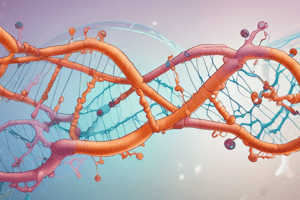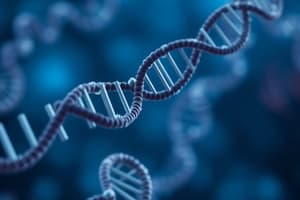Podcast
Questions and Answers
What role does the template strand of DNA play during transcription?
What role does the template strand of DNA play during transcription?
- It is translated directly into protein.
- It induces mutations in the RNA transcript.
- It replaces the coding strand during RNA processing.
- It serves as a template for the sequence of nucleotides in RNA. (correct)
How are codons in mRNA related to amino acids during translation?
How are codons in mRNA related to amino acids during translation?
- Every codon corresponds to a stop signal in translation.
- Each codon dictates the sequence of RNA nucleotides only.
- Each codon specifies a particular amino acid to be added to the growing polypeptide chain. (correct)
- Codons are read in the 3' to 5' direction.
What happens if codons are not read in the correct reading frame during translation?
What happens if codons are not read in the correct reading frame during translation?
- The synthesis will pause until the frame is corrected.
- Only the first codon will be translated.
- Translation will result in a completely different protein. (correct)
- The polypeptide will be synthesized correctly.
How many codons serve as signals to terminate translation?
How many codons serve as signals to terminate translation?
What modification is made to the 5' end of a pre-mRNA molecule?
What modification is made to the 5' end of a pre-mRNA molecule?
Which statement is true regarding the genetic code?
Which statement is true regarding the genetic code?
Which function is NOT associated with the modifications at the ends of mRNA?
Which function is NOT associated with the modifications at the ends of mRNA?
What is the main purpose of RNA splicing in pre-mRNA processing?
What is the main purpose of RNA splicing in pre-mRNA processing?
What are the segments of RNA that are expressed and translated into amino acid sequences called?
What are the segments of RNA that are expressed and translated into amino acid sequences called?
Which of the following statements about introns is true?
Which of the following statements about introns is true?
What is added to the 3' end of a pre-mRNA molecule?
What is added to the 3' end of a pre-mRNA molecule?
Which process directly results in a continuous coding sequence of mRNA?
Which process directly results in a continuous coding sequence of mRNA?
Which component is part of the pre-mRNA but not included in the mature mRNA?
Which component is part of the pre-mRNA but not included in the mature mRNA?
How many nucleotides correspond to one amino acid in the genetic code?
How many nucleotides correspond to one amino acid in the genetic code?
What separates transcription from translation in eukaryotic cells?
What separates transcription from translation in eukaryotic cells?
What is the initial RNA transcript called before processing in eukaryotes?
What is the initial RNA transcript called before processing in eukaryotes?
What is the role of RNA in the flow of genetic information?
What is the role of RNA in the flow of genetic information?
What are ribosomes primarily responsible for in the process of protein synthesis?
What are ribosomes primarily responsible for in the process of protein synthesis?
What distinguishes prokaryotic translation from eukaryotic translation?
What distinguishes prokaryotic translation from eukaryotic translation?
What results from the transcription of a gene?
What results from the transcription of a gene?
Which amino acid corresponds to the codon UUU?
Which amino acid corresponds to the codon UUU?
Which statement correctly describes the genetic code?
Which statement correctly describes the genetic code?
What does the presence of UAA or UGA in a codon indicate?
What does the presence of UAA or UGA in a codon indicate?
For the codon CUG, what is the corresponding amino acid?
For the codon CUG, what is the corresponding amino acid?
Which base must be at the 5' end of a codon to form AUG?
Which base must be at the 5' end of a codon to form AUG?
What is the role of transcription in gene expression?
What is the role of transcription in gene expression?
Which of the following codons is associated with Lysine?
Which of the following codons is associated with Lysine?
What does the 'universal' nature of the genetic code imply?
What does the 'universal' nature of the genetic code imply?
Which nucleotide is not a part of any codon for coding amino acids?
Which nucleotide is not a part of any codon for coding amino acids?
What process allows genes to be transplanted from one species to another?
What process allows genes to be transplanted from one species to another?
Which codon represents the start signal for protein synthesis?
Which codon represents the start signal for protein synthesis?
Which base is substituted for thymine in RNA?
Which base is substituted for thymine in RNA?
What is the role of RNA polymerase in transcription?
What is the role of RNA polymerase in transcription?
What is the function of the promoter in transcription?
What is the function of the promoter in transcription?
During transcription, which strand of DNA serves as the template for RNA synthesis?
During transcription, which strand of DNA serves as the template for RNA synthesis?
What term describes the length of DNA that is transcribed into RNA?
What term describes the length of DNA that is transcribed into RNA?
What process occurs after RNA transcription in eukaryotic cells?
What process occurs after RNA transcription in eukaryotic cells?
What happens to both ends of the primary RNA transcript during RNA processing?
What happens to both ends of the primary RNA transcript during RNA processing?
What is the final product of transcription in eukaryotic cells?
What is the final product of transcription in eukaryotic cells?
Which phase follows the initiation of transcription?
Which phase follows the initiation of transcription?
What signals the end of transcription in bacteria?
What signals the end of transcription in bacteria?
Study Notes
RNA Processing
- Each end of a pre-mRNA molecule is modified
- The 5’ end receives a modified guanine nucleotide cap
- The 3’ end gets a poly-A tail
- These modifications:
- Facilitate the export of mRNA from the nucleus
- Protect mRNA from degradation by hydrolytic enzymes
- Help ribosomes attach to the 5’ end
Introns and Exons
- Most eukaryotic genes and their RNA transcripts have long noncoding stretches of nucleotides that lie between coding regions
- These noncoding regions are called intervening sequences, or introns
- The coding regions are called exons
- RNA splicing removes introns and joins exons, creating an mRNA molecule with a continuous coding sequence
Transcription and Translation: Central Dogma
- The information content of DNA is in the form of specific sequences of nucleotides
- This leads to specific traits by dictating the synthesis of proteins
- This process is called gene expression and it involves two major stages:
- Transcription: synthesis of RNA under the direction of DNA
- Translation: synthesis of a polypeptide under the direction of mRNA
- Transcription produces messenger RNA (mRNA) which carries the code from DNA to the ribosomes
- Ribosomes are the site of translation
The Genetic Code
- The instructions for assembling amino acids into proteins are encoded into DNA
- The genetic code is a triplet code: a series of nonoverlapping, three-nucleotide words
- Each codon specifies the amino acid to be placed at the corresponding position along a polypeptide
- The mRNA codons are read in the 5’ to 3’ direction
Cracking the Code
- 61 out of 64 codons code for amino acids
- 3 codons are stop signals to end translation
- The genetic code is redundant, meaning more than one codon can specify a particular amino acid, but it is not ambiguous, meaning no codon specifies more than one amino acid
- Codons must be read in the correct reading frame to produce the specified polypeptide
Universal Genetic Code
- The genetic code is nearly universal
- Genes from one species can be transcribed and translated in another organism
- This is because the genetic code is nearly identical in all organisms, from the simplest bacteria to the most complex animals
Transcription: A Closer Look
- Transcription is the first stage of gene expression
- RNA synthesis is catalyzed by RNA polymerase, which pries the DNA strands apart and hooks together the RNA nucleotides
- The RNA is complementary to the DNA template strand
- The DNA sequence where RNA polymerase attaches is called the promoter
- The stretch of DNA that is transcribed is called a transcription unit
- The sequence signaling the end of transcription is called the terminator (in bacteria)
Eukaryotic RNA Processing
- Eukaryotic cells modify RNA after transcription
- The primary transcript is the initial RNA transcript from any gene prior to processing
- RNA processing involves the following modifications to the pre-mRNA:
- 5' capping
- 3' polyadenylation
- Splicing
Studying That Suits You
Use AI to generate personalized quizzes and flashcards to suit your learning preferences.
Related Documents
Description
Explore the fascinating processes of RNA processing, including modifications such as the guanine cap and poly-A tail. Learn about the roles of introns and exons in mRNA formation and the central dogma of molecular biology that outlines gene expression. This quiz will test your understanding of these critical biological concepts.




